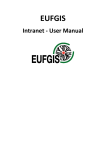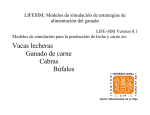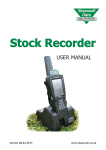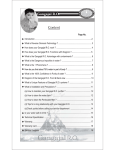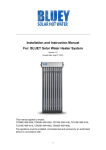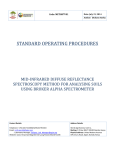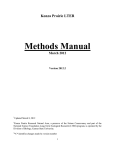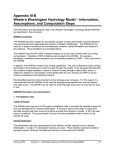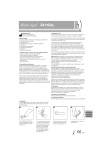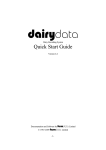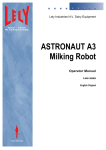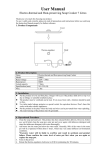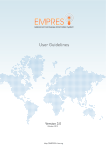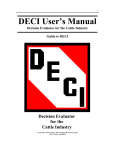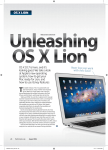Download User`s Manual LIFE SIM 2003 Dairy
Transcript
LIFESIM; Life Feeding Strategies Simulation models LIFE-SIM Version 8.1 Dairy Beef Goat Buffalo Centro Internacional de la Papa A milk and beef production simulation models 1 LIFESIM; Life Feeding Strategies Simulation models ®LIFE-SIM Version 8.1 A production simulation models designed to analyze different scenarios of feeding strategies Each corresponding model estimates milk or beef and manure production from different species (Dairy, Beef, Goat and Buffalo); also estimate methane emission based on the energy and protein balance between intake and animal requirements. Designed by: PhD. Carlos León-Velarde PhD. Raul Cañas Cruchuga PhD. Roberto Quiroz Guerra Ing. José Guerrero . [email protected] [email protected] [email protected] [email protected] Production Systems and the Environment Division International Potato Center (CIP) [email protected] http://inrm.cip.cgiar.org/ www.cipotato.org Av La Molina 1895 La Molina PO Box 1558, Lima 12, Peru 2 Introduction The Livestock Feeding Strategies Simulation Models, LIFE-SIM was developed by a team of the Production Systems and the Environment Division of the International Potato Center (CIP). The objective of the models is to evaluate the effects of different feeding strategies (scenarios) on animal performance. LIFE-SIM is comprised of four specific models related to ruminants (Dairy, Beef, Buffalo, and Goat) and one for non ruminants (Swine); only the manual for the ruminant models are described in this document. Each model is dynamic and runs in a probabilistic daily basis. Consequently, it is necessary to run each feeding strategy or scenario several times to obtain the average response for a herd or region. The components of each model include specific subroutines for pasture growth, voluntary intake, supplement availability, nutrient requirements, thermal regulation, milk – beef and meat production, manure production, methane emissions, and a bio-economic analysis. The structure of the models are similar and have the same inputs facilitating its management; however, for each specific model, appropriate parameter were incorporated to the equations allowing the evaluation of the animal performance for each species considered. Each model requires as inputs appropriate information on livestock characteristics, pasture and forages as cut and carry, weather conditions, supplementation, and the prices of feeds and products. Likewise, it is important and necessary to define the average characteristics of the specific animal of the herd or groups of animals within the herd or region. The information required for the animal component are: milk yield potential (measured on a specific lactation curve of animals into the farm or area in analysis), age, body condition and chemical composition of milk or meat, the stocking rate (number of animals per hectare), as well as the potential feed intake (as percent of the body weight) and the expected variation in feed intake. Models considering the first month when calving occurs estimate outputs from those inputs for a year covering the whole lactation or fattening period. During the process, the model estimates forage availability in relation to the changes in feeding practices during the year. The outputs of the LIFE –SIM models are the expected milk yield during the lactation period, the changes in body weight during the same period, the gain weight during a fattening period, the amount of manure produced, and an estimate of methane emissions. Additionally, the model provides estimates of the total costs of production per cow 3 per lactation, and the average cost per kilogram of milk. The LIFE – SIM models contain six main input modules: animal, pasture and forage, supplementation, weather conditions, supplement strategy, and cost. The animal component inputs information considering the animal’s genetic potential, physical state, and response to the nutrients provided by pasture, forage, and supplements. Models predict responses by energy or protein; thus, it uses the minimum value calculated to determine the real production of milk or meat. The pasture component is dynamic, and depends on the seasonal distribution of rainfall and temperature, which affects forage availability and quality, as well as animal performance. The supplement input module accounts for the additional feed provided to livestock and includes the nutritional characteristics of the supplements. Both modules have a sub-module that accounts for the order in which the food sources are consumed. The climate module determines the effects of temperature, relative humidity, and wind velocity on feed intake as they influence milk or meat production. The cost module inputs information necessary for a benefit-cost analysis based on the daily feed cost and its contribution to total costs in relation to milk production (Leon-Velarde et al, 2003). In summary, LIFE SIM models become a practical tool for the evaluation of different feeding strategies in terms of their biophysical and economical performance. Output variables, like milk or meat production, economic gross margins, and methane emissions can be used with other models to calculate the function that best links feed intake with economic gross margins and methane emissions and manure. In this User’s guide, you will be introduced to the different sections of the LIFE SIM Simulation Model. The CD includes specific programs for ruminant’s species: dairy, beef, Goat and Buffalo. The structure of the models are the same, however each species has its own parameters, therefore we will be using the Dairy model as example. From data input to simulating and saving the file, you will be assisted step by step how to generate results in tables or graphs monthly, weekly or daily. The content of this manual is furnished for informational use only, and is subject to change without notice. However the model includes information similar to the presented in this manual. Also a section with model use on analysis of scenarios is presented. 4 Starting off Before doing anything else, you must be sure that your computer has the following features for installation: 3 3 3 3 3 3 3 3 Windows 95, 98, Me, NT, 2000, XP Pentium ® class processor 100 mhz 16 MB RAM 20 MB HDD available space Monitor SVGA – 256 colors at 800 x 600 display resolution CD-ROM Drive Mouse Please check the regional settings. Change the use of comma (,) for dot (.) to separate the decimal point. Once verified, obtain the corresponding program of simulation model from the CD LIFE-SIM: 3 3 3 3 Dairy Beef Goat Buffalo With the simulation CD at hand, let’s do these steps: ) ) A note recommending that you close all applications will flash. Click OK. Insert the CD-ROM in the CD drive 5 ) ) ) Open the Windows Explorer, look for the CD drive and click to open. Find the corresponding model and click. You will find this. Double click the one with arrow (Setup. application) to start installing the program (for example) You will then see this (a) on your screen. The program will normally be installed in a group denominated LIFESIM C:\Program Files\LIFESIM. If you are ready to install, click the computer icon pointed out by the arrow. (a) ) (b) This will start the installation in your Program Files under the name of the program. The program will be installed in the LIFE-SIM program group. You can choose other name. 6 Once installed, you can access the appropriate Simulation Model by hitting and following these steps: Start menu Program LiFE-SIM Dairy (with icon) You can make a shortcut by doing the following steps: 1. Start menu 2. LIFESIM 3. Dairy (right click) 4. Create Shortcut (send it to your destock (1) (2) (3) (4) (5) Each time that you need to reinstall or up date the program it will be necessary to uninstall the previous version. To uninstall a program, follow these steps: 1. From Start select Settings, Control Panel, Add/Remove Programs 2. Select the corresponding program and press the Add/Remove... button. Then follow the same previous steps to install the new version. 7 Running the model. Select the appropriate model and press the icon of the model. The computer will load the program What is this? This is the main window or menu of the models upon hitting the shortcut icon of Dairy Cattle Model on the desktop or opening the model from the start menu. These icons will be your signs along the Simulation Model On the top, Scenario, Conditions, Simulation, Report, Help and Exit include the same steps showing on each icon: these are new conditions, open, erase scenarios, save, animal, pasture, supplements, Weather, cost, simulation, text reports, graph reports, and exit. New Conditions Open icon - This icon is used if you need to open existing file previously saved or file imported from the diskette or from other sources. 8 Erase Icon This icon is used if you want to erase scenarios or simulation runs. The maximum number of simulation runs is 9. If you already run a simulation using a set of data and want to make another simulation using different set of data, you have to use this icon to delete the previous results and not get you confused with the new results. Save icon Used after you have inputted necessary data for simulation. This is need if you want to save changes you have made with the current data. Animal. this icon is composed of animal characteristics, dry matter intake, localization and potential milk yield. More details are discussed on the later part of this manual. Pasture Icons available for forages on grazing cut and carry and browse. This following information is particularly important: amount given in dry and fresh matter, its average monthly digestibility and protein content, stocking rate, growth rate of pasture/day. More details as we move on. Supplements This is composed of concentrate, complementary forage, and or other supplements. Important information that should be available is: dry matter, protein content, digestibility, cost and amount to be given. Feeding Strategy In this window you can combine the order of the feeding strategy. Weather. You have the option to use or not to use temperature regulation. If you choose to use temperature regulation, average monthly temperature, humidity, wind velocity and skin thickness are the information you need to fill in. 9 Cost You have to provide feed costs based on existing local prices. These include the feeding costs from pasture, cut and carry. Complementary forages, concentrate, other supplements are from the feed user table. The feeding cost as percentage and the milk price. Simulation Click this icon to start the simulation. You will be asked what month simulation will start (pertaining to the month of calving) and interval of the text reports (daily, weekly, and monthly). Text reports It will show detailed and summary reports. The number of reports depends on the number of simulations done. There is several information derived from these report. Details are discussed on the latter part of this manual. Graph reports Line and bar graphs as results from the simulation of parameters are featured here. Milk production, methane emission and scenarios are shown. As well as production cost. Exit Click this icon if you want to quit or are finished using the model. Model will ask to save the last condition (feeding strategy). Help In this you will find information regarding the model. If you get lost with the process of simulation, use this as your guide to what information is needed where 10 Starting new file The model by default loads a example of a feeding strategy. From it you can change the new conditions or open a file with your work data To start off, click the Animal icon found at the main page of the simulation model. It will open up a set of windows for animal description. Animal description The first set has 4 windows. a) b) c) d) Animal Adjustment values Potential intake Potential yield a) Animal Identification. The name of the animal or group of animals can contain number, letters or both. The word or number you input cannot have spaces, otherwise the model will only consider the first set of letters or numbers. Example: Rose III = Rose CIP-Dairy = CIP-Dairy 11 If you are running a herd, set the cow name as Group. There are two options. A) run the average type of cow, b) Divide accounting the number of animals in the herd in three groups: I, II and III. The I correspond to top cows, II the average cows and III the last portion of the herd. This will allow you to calculate a total herd cost-production. Age. Age must be expressed in years. Therefore, if you have the age of the animal in months, you need to covert it into years according to the following formula (use values up to 2 decimals): age (years) = Age (months)/ 12 Weight. The weight must be expressed in kilograms. The range of weights that the model accepts for a dairy cow should be within the range 300 – 600 kg. Any values beyond these limits will be ignored. Lactation number: Milk production is affected by number of lactation; therefore the model considers an adjustment factor by lactation number. Lactation length. This is the length (in months) of lactation period a dairy cow before it reaches its dry period. The length should be between 1 – 10 months, otherwise it will be ignored. Calf weight Expected at birth. Estimate weight of the calf at birth. The value allows estimating the cow weight increment during the pregnancy. Gestation length. The average is 282±3; however, in some cases the value can vary, but not less tan 279 days Calving interval; The model estimate the beginning of new pregnancy based on the data of calving interval and gestation length. Lose weight during the first three months of lactation period. Represents the tissue mobilization to produce milk during the first three Protein turn-over. Is the quantity of nitrogen recycled by the animal, when the diet protein level is low. Grazing correction factor. Represents the energy required for the animal for physical activity under grazing conditions. Energy concentration required to gain 1 kg body weight. Is the quantity of energy of one kilogram of muscle; it is used to calculate the weight gain by energy intake. Milk fat content. Represents the fat content of the milk; expressed in percent. 12 b) Adjustment values. In this window there is information for energy and protein concentration required to gain one kilogram of weight. Also values referring to protein quality index are showed. You can modify then if you know its value, otherwise use the default values. Potential intake Dry matter intake. This is defined as the maximum dry matter amount an animal can intake based on its physical limitation; which is based on its rumen capacity and palatability. Usually the values vary from 2.0 – 4.0% of the animal’s body weight. Beyond these limits, the model will under-or over-estimates the results. Variation of the potential intake. This is the daily variation of animal dry matter intake. This means the percent of the average potential intake of the animal. For example, your animal’s average potential intake is 3.5 kg DM/100 kg body weight. But in some days, your animal will take a little more and other day less than 3.5 kg DM. Therefore, this difference (in percent) from the average is the variation of potential intake. You can select a value between 1 – 10%. Displayed is a reference table of metabolic and body weights. Browse. Complete on what percent is taken from the total dry matter when the animals are expose to browse. In similar form define the increment in percentage of dry matter intake due to the lactation. 13 d) Potential yield Now click on the third window, Potential yield. Displayed here is the lactation curve drawn from the values of the parameters (also presented in this window). These lactation curves vary from each animal; it has influence the breed, feeding and management; therefore it is highly recommended that the lactation curve should be define for the herd (average). By default in the model appears a lactation curve from Bolivia. This can be change from the database. This will be show when you click on “define parameters”. From that table, you can choose the appropriate lactation curve matching with your average cows. However the better is to have your own parameters. The model also has the options to create a lactation curve based on the potential yield of the cows. Click on “Potential milk production input” and complete the information requested; you can see what happen with curve. Always the production follows the same shape. This is due that is constructed on a typical lactation shape. Shop map. The model shows a map with countries were the LIFE-SIM was used and tested. These countries are shown in the map 14 On “Define Parameters” there is a table which contains a database with parameters describing lactation curves for the animals in different countries. You can add values of animals from your area. It is important to note that only in this window can you change, add or delete values (and not on the potential yield window). Selecting and applying the curve will then reflect it on the Potential yield window. So what am I going to do with the first section of the model? You can apply it in this phase an exercise by using on each cell the values that you have related to your area. After complete the fist section save your “conditions” with a filename in an appropriate folder (you can create it) with a corresponding name to your work 15 Weather Now click this weather icon on the main menu. Here, you have the option to use or not to use temperature regulation. Not use temperature regulation. In this option, the model assumes a thermo neutral zone. This means that the animal is in a zone of comfort Use temperature regulation. If you are going to use this option, you need to have data of the following parameters: average temperature (ºC), humidity (%) and wind velocity (km/hr). You can get the necessary data from your local weather station or from other agencies which have been collecting climatic data over the years and have established a pattern on the climatic situations of your area. Another data required is the animal’s skin thickness. From this section, you can run the model by using and not using temperature. Note the milk production results in the graph report. Don’t forget to save your conditions on each section 16 Pasture description Click to open the windows for the pasture availability. This set has 3 windows: Pasture, Cut and carry and Browse. On pasture and Browse you can complete the information by month, season or annual average (combinations of then are allowed. a) Pasture refers to the forage source where in the animals are grazing. Dry matter availability. The first columns of cells are the monthly availability of pasture. Take note that the forage available at the pasture is for grazing. Usually the limits for monthly availability are 400 to 4000 kg DM/ha Use of growth rate of pasture. Growth rate of pasture refers to the amount of Dry Matter that the pasture grows . ; when per day. You can use this option only If you don’t have data about the availability of pasture; click using this option it is important that you have the initial data of dry matter availability, then fill in the average growth rate/month on cells found in the first column and the rest of information. 17 Digestibility information. The second column is for the digestibility information. Digestibility information can be done monthly (a), by season (b) or its annual average (c). For data available monthly, enter in the average values corresponding to the month. If this digestibility is to be presented by season, average value/season should be inputted, as well as the months of dry season. If the data available is just for annual, input the average value (this should be between 1-60%). (a) (b) (c) Protein information. For the third column, information required is the protein content of the pasture. Just like the digestibility information, you have the option to input the values monthly (a), by season (b) or its annual average (c). If you have monthly data available, input the average values into corresponding cells of the months. For per season, input the average/season and identify the dry months by marking boxes corresponding to the months. For annual average, just input the monthly average and it should be within 1-90% CP. (a) (b) (c) Dry matter content. One has to input the values by its annual average or by season Stocking rate. The stocking rate is usually measured in terms of animal units (a.u.) per hectare. This is the rate at which grazed animals are stocked. This is important for it will affect the production/unit area of pasture. 18 b) Cut and carry Cut and carry feeding system, otherwise known as stall feeding, is done when the forages are obtained from different areas and brought to the animals housed in pens or stalls. Basic nutrient composition like fresh and dry matter content, digestibility and protein are to be provided (but take keen note of the units used). Mark the boxes under Cut and carry column on months when the animals are not grazing and fed exclusively by cut and carry. But if the animals are grazed and are also fed by cut and carry, fill in only the columns for fresh matter (in kg) and dry matter (in %) contents of forages and/or weeds of this window. 19 c) Browse In some cases animals are expose to browse (agro-silvo-pastoral systems), therefore in the model includes an estimation of consumption from the total dry matter. In the windows of potential intake you have completed the percent for browse from the total dry matter intake. The information can be completed by month, season or annual average. Complete the information with your own data. The values are corrected by the browse area condition. Values are expressed in percentage from 0.01 to 1. 20 Supplements description Now to open up another set of windows, click from the main menu to enter into supplements description. There are 3 windows available for supplements. Each of these requires information on: name, dry matter, digestibility, protein, energy and cost. These must be filled in according to the supplement using during the year. The next column refers to the average amounts per month (kg/animal/day) available for the animal to offer. You can observe that months are arranged from January to December but also correspond as months 1 to 12. Thus “Month 1” corresponds to the start of lactation and calving period. Therefore you must input the amounts of supplement given during this lactation period until the amount of milk produced wanes. You can find the same format with the next 2 windows. To include a new supplement go to “make a supplement for a feeding strategy”. On this window you will find the windows “making a ration” and “database of feeds”. Both windows will allow you to make a new supplement which can be store into a “Ration data base”. To start a new supplement goes to “make supplement for a feeding strategy”. 21 Making a supplement. There are 10 available rows for the feed ingredients. You must create a new user database with ingredients from the “Database of feeds”. Go to this information and the appropriate ingredients that are in your area. Database of feeds. This database has available feed ingredients. Which, you can not erase it. However you can add or erase new feeds. To add a new feed be sure of its real availability in time within a particular zone. Complete the information required; this can be in fresh or dry matter basis. The information will be saved on dry matter basis. From the table select the feed ingredients to include into your “Feed user table” in “Making a ration”. When you complete it you must update your “Feed user database. This will be stored to be the same, unless that you modified again following the same steps described before. Define the “Price” of each new ingredient. From the “Feed user table” select the ingredients of the new “supplement”. Complete the price and the quantity or proportion and press “Make balanced feed” . Complete the name and save into the “Ration management”. Press it. In this table you can store all new supplements to be used n the analysis of different strategies. Return to the “Making a ration” and “close” You will return to the “Supplements”. Press “Selects a ration” and complete the amount for each month. You can make combinations of them during the year. 22 Feeding Strategy Press to define and to organize the form that you are feeding the animals. By default the last feed is “Grazing”. Due to the cost of supplements the model uses first the order of the concentrates. Cost Now for the last set of data needed to run a simulation, is the cost; click from the main menu. Basically, this window contains all feed costs (e.g. forages and supplements) and its percentage to the total production cost. You also have to indicate the currency used. Since the window under the supplements section has available cells for costs, it will automatically be reflected on this section. Complete the price of forage and “cut and carry”; you can add a value of “Browse” on the grazing situation. Finally set the current sale price of milk in your area. Save your information. 23 Saving the file Before to start the simulation process, save the file with the conditions introduced. To do this, follow the steps: 1. Click the Save icon found in the main menu. 2. Just like saving a file enter the name of your file in ‘File name’. The name of you file should be distinct of the type of data available. Usually, the file name includes the major feed/supplement used as feeding strategy. 24 Generating simulation scenarios Simulation In the previous sections, you were asked to input several data needed to generate our simulation. The data that have been inputted will produce what we call ‘scenarios’. These scenarios are presented as text reports and graphs. For our model, you may run a maximum of 20 scenarios, generated either from one or several data files. However it is recommend not saturating the graph and text report. Since the program is stochastic, it will give relatively different result each time you run a simulation. This is due to the value of variation of potential intake (you can find this under DM Intake, Animal description). Each simulation run affects the value the potential intake, giving different production results everytime. The type of results will be discussed in detail later. To get the best estimate of production potential of the animal, it is best to run a simulation 3-4 times/data file. Get the average of the summary results of all the runs of each data file and you’ll get an average as better estimate. Now click simulation icon from the main menu and let’s start the most awaited simulation. You will see the window on the right when you click the Simulation icon. It has 4 available cells and 4 buttons for commands. Scenario description. Type the name of the feeding strategy that your going to run/. Text report’s interval. This refers to the interval you want the results be presented. You can have it daily, weekly or monthly. To do this, click onto the choice of interval and done. 25 Month simulation starts. This refers to month of calving. In general month 1 refers to January and month 12 to December. However if you choose, for example “July”, this becomes as Month 1 and so on finishing on next June as month 12. Consequently your data need to be in accordance with the feeding strategy, temperature and so on. Simulation time. You can choose the time interval of your simulation. The recommend action is the complete year because this will reflect the lactation curve and the dry period over an ideal of 12 months of calving interval. 26 The results… Text reports These reports can be viewed by clicking the icon from the main menu. You will be given detailed and summary reports. Detailed reports will give results per day, week or monthly basis depending on the choice you made in the simulation section. Table 1, 2 and 3 show the valued obtained from your simulation. See each table to identify the value or result that you are using as main indicator of the feeding strategy under evaluation. Check your values with the obtained from a real situation. You have the option to either copy this report or paste to Excel or Notepad, export as Word Document or print it as is. Table 1. Text result for weight, milk, cost, and methane, manure and nitrogen. -------------------------------------------------------------------------------Scenario number: 1 Scenario running on month: January Description: Example simulation -------------------------------------------------------------------------------- Weight Initial weight Weight at end of lactation ( 304 days ) Weight at end of the year ( 365 days ) Calving per year Weight after calving Average daily weight change ( 365 days ) Average daily weight change after end of lactation Calf birth weight Milk production Potential milk production per lactation (mature age) Actual milk production per lactation (corrected/lac) Lactation length Milk production per day 380.00 543.00 561.60 0.87 526.00 0.498 0.221 25.67 2703 1018 310 3.28 kg kg kg kg kg kg kg kg/lactation kg/lactation Days kg/day Cost The costs are expressed in : Sale price of milk Cost per kg of milk US Dollar 0.35 0.21 $/kg $/kg of milk 27 Gross income per kg of milk Total production costs Percentage of feeding cost Total gross income Gross margin Income/Cost Ratio 0.14 208.76 50.00 356.32 147.56 1.71 $/kg of milk $ total % of total cost $/Year $/Year 139.91 100.17 1387.40 3.13 43.45 0.119 l/year kg/year kg DM/animal/year % kg/year kg/day Methane & manure Total methane emission Total methane emission Manure excretion Nitrogen proportion in the excreta Total nitrogen excreted Daily nitrogen excreted Table 2. Text result for total dry matter intake -------------------------------------------------------------------------------------------------------------Scenario number: 1 Scenario running on month: January Description: Example simulation (kg of Dry Matter) -------------------------------------------------------------------------------------------------------------Day Potential DMI Feed Concentrate Cut and carry Brewer grain UMMB Browse Grazing 1 11.07 Offered 0.45 0.00 0.00 0.00 0.00 10.63 8.97 Intake 0.45 0.00 0.00 0.00 0.00 8.52 2.11 Rejected 0.00 0.00 0.00 0.00 0.00 2.11 30 10.88 Offered 0.45 0.00 0.00 0.00 0.00 10.44 8.92 Intake 0.45 0.00 0.00 0.00 0.00 8.48 1.96 Rejected 0.00 0.00 0.00 0.00 0.00 1.96 Continuation …. 330 18.16 Offered 0.00 0.00 0.40 0.00 0.00 17.76 13.68 Intake 0.00 0.00 0.40 0.00 0.00 13.28 4.48 Rejected 0.00 0.00 0.00 0.00 0.00 4.48 360 16.46 Offered 0.00 0.00 0.40 0.00 0.00 16.06 13.05 Intake 0.00 0.00 0.40 0.00 0.00 12.65 3.41 Rejected 0.00 0.00 0.00 0.00 0.00 3.41 28 Table 3. Results on dry matter availability from grazing. ----------------------------------------------------------------------------Scenario number: 2 Scenario running on month: January Description: Example simulation ----------------------------------------------------------------------------Simulation Dry matter Dry_matter Dry_matter Growth Senescence day availability intake intake (d) (kg_DM/ha/d) (kg_DM/an/d) (kg_DM/ha/d) (kg_DM/ha/d) (kg_DM/ha/d) 1 1212.7 8.5 10.7 36.2 12.7 30 1384.5 8.5 10.1 36.2 22.1 60 1458.7 10.8 12.1 46.1 26.1 90 1564.6 10.9 11.5 46.1 33.5 120 1529.8 11.9 12.0 42.8 31.2 150 1449.0 8.7 8.6 36.2 26.1 180 1390.2 12.0 11.6 32.9 22.6 210 1336.3 11.2 10.6 29.6 19.6 240 1281.0 10.5 9.8 26.3 16.7 270 1225.8 11.5 10.6 23.0 14.0 300 1258.4 11.7 10.4 26.3 15.5 330 1310.2 13.3 11.6 29.6 18.1 360 1359.2 12.6 10.9 32.9 20.8 29 Graph reports To open this section, click the Graph Icon found on the main menu. The graphs are grouped into milk production (E:)P), Milk, Weight, Methane, Economic, Production, and Production cost. The graphs showed the results obtained from the last scenario simulated. All these graphs are shown on a yearly basis. Milk production. Here you can view the graphs for energy intake, body weight and milk production in balance with energy and protein. Milk is produced following minimum rule. Milk production presents 2 line graphs: potential milk production and production as simulated by the model. The red line represents the potential milk production of the animal as identified in the Animal section. The second line, green line, is the milk production based on the feeding strategy that was evaluated. The difference between both curves is the amount of milk the animal cannot produce due to several factors such as low nutritional content of feeds given and low feed intake. The unit of this parameter is kg milk/animal/day. Body weight is the variation or changes in live weight (kg) along the lactation period (per month). Though milk production is the focus of this model, the body weight changes are also being looked into. This could show if the 30 feeds given could relatively sustain the animal (for production and maintenance) throughout the period. This is presented as line graph. Methane emission. In here, you will find the cumulative methane produced per animal unit per month. Methane emission per DM intake is related to the amount of feed consumed by the animal. This is computed using the formula below: liters methane (CH4)/day Methane/unit of feed = Kg DM consumed/day Methane emission per milk produced relates to the emission to the amount of product. The values were obtained using the formula below: Methane (L)/day Methane/kg milk = Kg milk/day Manure production is the estimated amount of manure produced based on the amount of digestible feeds consumed by the animal. Data result is the text reports. Comparison of scenarios This option is presented so as to compare the results of the scenarios simulated. It includes three windows: Economic, production and cost production. Following graphs show the results obtained. In economics is presented the gross margin obtained with income and total production cost ($/lactation period). In production is showed the milk production (kg per lactation)). The third graph shows the production cost per kilogram of milk ($/kg of milk). 31 32 Running simulations To run a new set of conditions make sure about the changes on each section. You can run any conditions, but to analyze a particular situation the new conditions should be in relation to the reality. Sharing new data for simulation The data used for simulation can be save as Notepad file. Because of this, you can share data with your colleagues. Sharing data could mean either providing a copy of your data to a partner or you getting a copy of their data. You can exchange the file with the NAME of your feeding strategy. Providing a copy of your data Open your Windows Explorer Under C: drive, find Program Files folder Open Dairy folder, find the specific file and copy it Paste the file into the diskette • • • • Importing a data file • • • Get hold of data file in a diskette or as attachment from an email If the data is from a diskette, copy and paste it to directory C:\Program Files\Dairy If data as attachment from an email, using the mouse, right-click on the file and Save as ‘Filename’ on the directory C:\Program Files\Dairy Once on the Dairy Cattle Simulation Model, you can open the imported file by following the steps in Open File section and do the rest of the steps to run some scenarios. The sections and steps presented in this manual for Dairy Cattle Simulation Model are somewhat the same with the models for beef cattle, buffalo and swine. Once you are familiar with the Dairy Cattle Simulation Model, it will just be a breeze for you when you try the other models. 33 LIFE-SIM use. This section shows some examples of the LIFESIM use. 20 10 Figure 1. Effect of sweet potato dual-purpose supplementation on goat grazing at different quality of pasture 62 2.3 60 55 n 2.6 tatio n e Pas 1.5 ture lem ay p dige 0.8 sup mal d stib o 0.4 t i ility ota g/ an % p t K ee Sw 50 0 47. Increment of live weight / day (g/day Considering the area of Piura, a goat model simulation was developed to analyze bio-economic scenarios for feeding strategies. The model in a daily step includes a sub-routine for intake, temperature and economy. It was used to evaluate the use of sweet potato dual purpose. Figure 1 shows the effect of supplementation of sweet potato at different level of pasture digestibility. The scenario evaluated 60 indicates that the supplementation between 1 to 2 kg of sweet potato contributes to obtain an increment of weight at 50 different pasture quality. Results obtained will be used for 40 animal trial evaluation. 30 Crop-livestock –environment In the crop-livestock production systems, the cattle play an important role. However, it is also considered a problem in relation to methane emissions. By using “Dairy” model simulation, combined with a database of farms from the Altiplano of Bolivia was analyzed several bio-economic scenarios. The objective was to determine the change of the nutritional plane in relation to methane emission and level of production. Figure 4 shows the evaluation of four scenarios including creole and crossbred grazing on pasture with 25% and 75% of alfalfa. 34 Emission of methane l/kg milk 0.15 Group 1 Group 2 0.1 Figure 4. Bio-economic scenarios of crop-livestock in the Altiplano of Bolivia using different cattle and proportion of alfalfa Group 3 B C A D 0.05 C B 0 0 0.05 0.1 0.15 0.2 Gross margin US$/kg milk Scenario A: Creole / crossbreed 25% alfalfa B: Creole / crossbreed , 75% alfalfa The scenarios analyzed give three groups. The first group includes the scenario A and B with a levels of gross income up to 0.055 $/kg and 0.065, respectively. The second group includes scenario C and part of D. The range of gross income goes from 0.08 to 0.14$/kg. The scenario D present a gross income from 0.11 to 0.19 $/kg. The results of trade-off of A and B shown that is possible to maintain the gross income with a 28% of methane reduction. The scenarios C and D have a similar response. C: crossbreed , 25% alfalfa The reduction of methane of scenario D gave a 13% less of methane emission that scenario C. The feeding improvement of the crossbred cattle increased the level milk production by 40% of gross income by kilogram of milk. The change of creole/crossbreed to crossbreed cattle under same feeding regimen increase milk production maintaining the same level of methane, however increasing the proportion of alfalfa increase level of production reducing methane by kilogram of milk produced D: Crossbreed, 75% alfalfa . 35




































